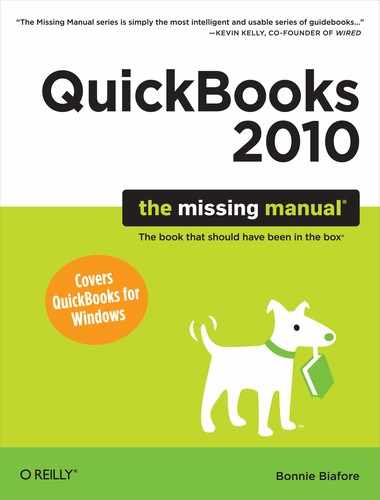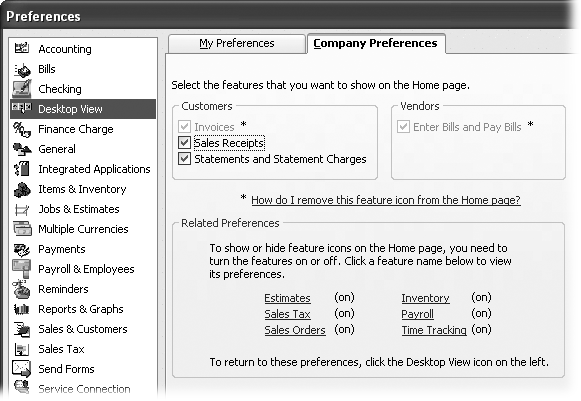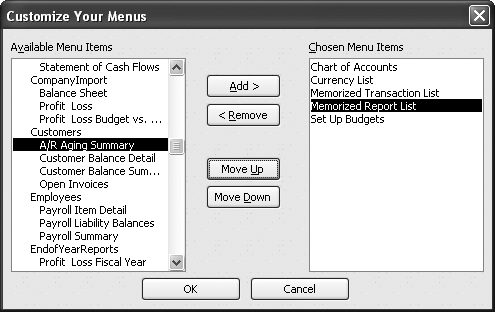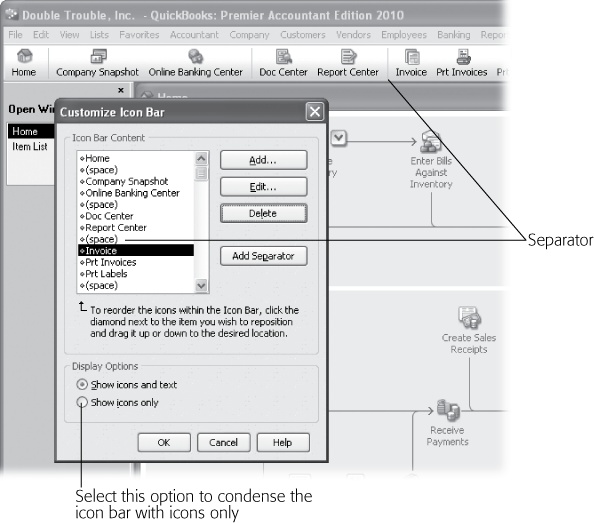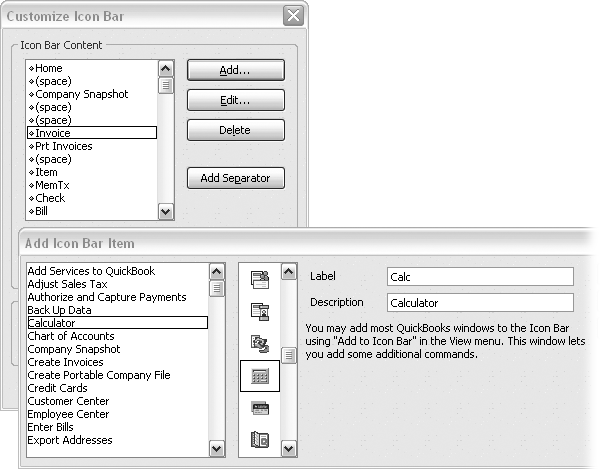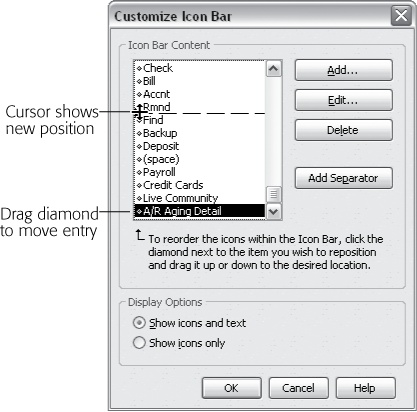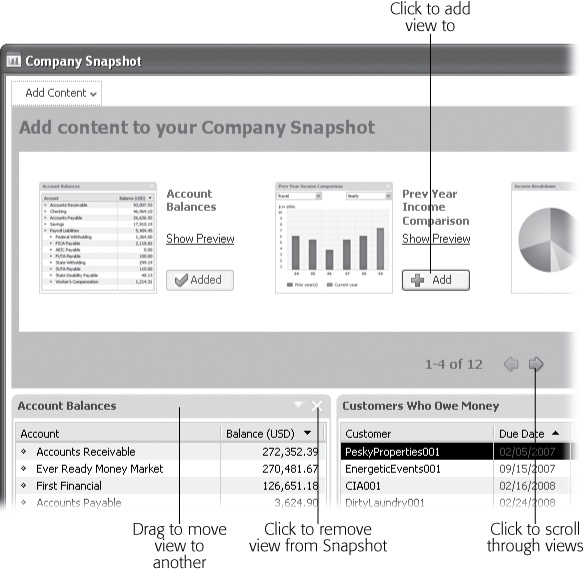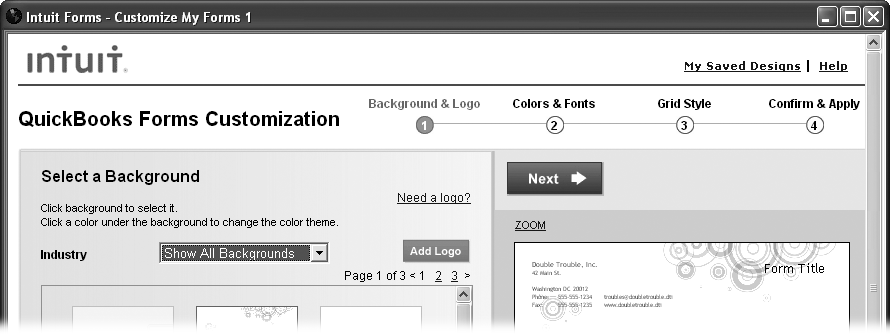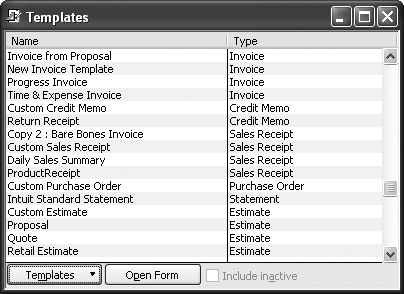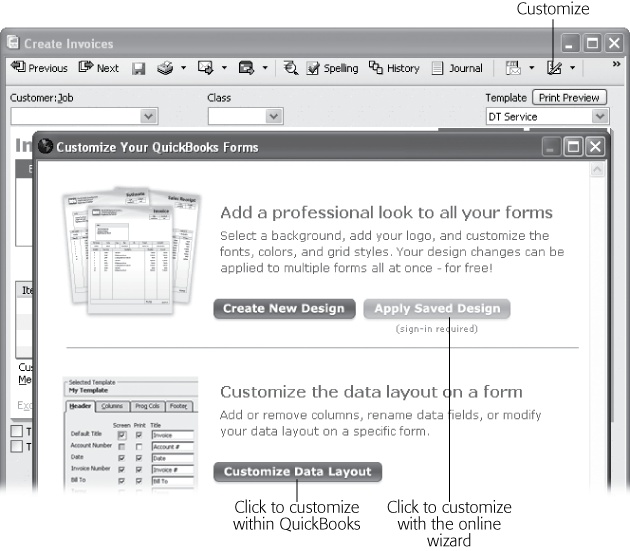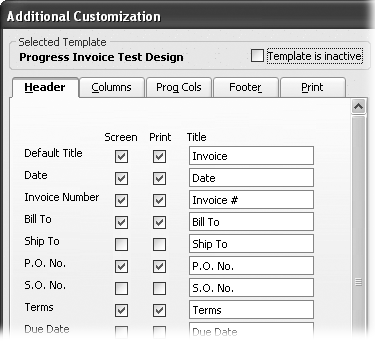Chapter 25. Customizing QuickBooks
Laid out like the workflow you use when you’re bookkeeping, the QuickBooks Home page provides instant access to all the accounting tasks you perform. Among the Centers for vendors, customers, and employees, and your old friend the QuickBooks icon bar, you can take your pick of helpful shortcuts to the features you use the most.
But your business isn’t like anyone else’s. If you run a strictly cash sales business, you couldn’t care less about customer lists and invoices; making deposits, though, is a daily event. You don’t have to accept QuickBooks’ take on convenience. The Home page and the icon bar come with a set of popular shortcuts, but you can add, remove, rearrange, and otherwise edit which features appear. In QuickBooks 2010, you can also add your favorite commands, windows, and reports to the new Favorites menu on the program’s menu bar. This chapter covers all your options.
QuickBooks helps you get up and running with built-in business form templates. They’ll do if you have to blast out some invoices. When you finally find a few spare minutes, you can create templates that show the information you want, formatted the way you want, and laid out to work with your letterhead. Create as many versions as you want. For example, you can create one invoice template to print to your letterhead and another that includes your logo and company name and address for creating electronic invoices to email. This chapter describes the most efficient ways to create forms—using QuickBooks’s new form designs or using built-in templates as a basis for your own forms. In Appendix E (www.missingmanuals.com/cds), you can learn how to fine-tune your forms with advanced customization techniques and even start templates from scratch.
Customizing the Desktop
Everyone who uses QuickBooks can make the program’s desktop look the way they want. Choosing the Online Banking Mode gives the full scoop on how you can customize the desktop to look the way you want. Here are the different ways you can make the desktop your own:
One window or several. You can focus on one window at a time with the One Window option. The Multiple Windows option lets you see several windows at once.
Show Home page when opening a company file. The Home page (Getting Around the QuickBooks Home Page) shows the entire workflow of your accounting tasks along with popular windows and tasks like the Chart of Accounts window or writing checks.
Show Coach window and features. If you want QuickBooks to help you learn how to use its features, turn on its checkbox so the Coach walks you through using the program.
Show Live Community. If you have a lot of questions about QuickBooks, keep the Show Live Community checkbox turned on. With this setting, QuickBooks automatically opens the Live Community window (Live Community). You can search for answers from experts or your peers. The Live Community window also has a Help tab that displays QuickBooks’ Help topics.
Detach the Help Window. You’ll want to turn this checkbox on (new in QuickBooks 2010), because it tells the QuickBooks’ Help window to play nicely with other windows on your screen (Live Community). You can position it where you want on the screen, resize it, or minimize it.
Choosing colors. If you want to change the color scheme that QuickBooks uses, choose one of the built-in color schemes from the Color Scheme drop-down menu.
Customizing the Home Page
The QuickBooks Home page is a chameleon that changes to fit your business’s workflow. The program performs its magic by incorporating your answers from the EasyStep Interview with your company-wide Desktop View preferences, as shown in Figure 25-1. For example, if you don’t have inventory, the tasks for buying, receiving, and paying for inventory are nowhere to be seen on your Home page. And if you don’t have employees, the employee panel disappears. See Choosing a Color Scheme for the full scoop on changing the icons you see on the Home page.
Fast Access to Favorite Commands
In addition to the Home page, QuickBooks has two other ways to get to your favorite features fast: the Favorites menu (new in QuickBooks 2010) and the icon bar. Out of the box, the Favorites menu is nearly empty and waiting for you to add your favorite commands and reports. QuickBooks’ centers and icons for other popular features fill up the icon bar from the get-go, but depending on how you like to work, those icons may languish unclicked. This section describes how to fill the Favorites menu with your favorite commands and modify the icon bar to display only the features you want.
Building Your Favorites Menu
The Favorites menu, which appears to the right of the Lists menu on the QuickBooks menu bar, has only one entry initially: Customize Favorites, which opens the Customize Your Menus dialog box. Despite the name, it lets you customize only the Favorites menu, but you can add almost any command or report to that menu.
In the Customize Your Menus dialog box, the Available Menu Items list is a directory of every feature QuickBooks has to offer. From the Lists menu through to the Help menu, every command on every menu and submenu on the QuickBooks’ menu bar appears in this list. The top-level menu bar entries are aligned to the left side of the list box. Menu entries are indented, and submenu entries indented even more. Even the Reports section leaves nothing out—you can choose any built-in, customized, or memorized report in your company file.
Adding a command to the Favorites menu is easy. Select the command in the Available Menu Items list and then click Add. The command appears in the Chosen Menu Items list, as shown in Figure 25-2. Click OK to close the dialog box.
Customizing the Icon Bar
The icon bar, which appears below the QuickBooks menu bar, includes icons that take you to some of the program’s popular features like QuickBooks centers, Reminders, Search, and others depending on the QuickBooks edition you use. You can modify the icon bar to add your favorite commands, memorized reports, or windows you open often. What’s more, you can change the appearance of the icon bar in several ways, as described in the following sections.
Here are the basic steps for saving icon bar customizations:
Choose View → Customize Icon Bar (or click the double right arrows on the right end of the icon bar, and choose Customize Icon Bar).
The Customize Icon Bar dialog box (Figure 25-3) opens showing the current list of icons.
As described in the following sections, add other shortcuts to the icon bar, remove icons for features you don’t want, edit, or change the order in which they appear.
The icon bar immediately shows the results of the changes you make in the Customize Icon Bar dialog box.
To save the icon bar, in the Customize Icon Bar dialog box, click OK.
Adding and removing icons
If you know which icons you want and don’t want, you can make those changes in one marathon session. First open the Customize Icon Bar dialog box by choosing View → Customize Icon Bar. To remove an icon from the bar, simply select the entry in the Customize Icon Bar dialog box, and then click Delete. Adding an icon takes a few more steps:
In the Customize Icon Bar dialog box, select the entry where you want to insert the new icon.
In the Icon Bar Content list, the entries appear one below the other. This order translates into icons from the left to the right on the icon bar.
Click Add.
The Add Icon Bar Item dialog box opens, as shown in Figure 25-4.
In the list on the left, click the window or command you want to add, like Chart of Accounts to open the Chart of Accounts window.
Tip
See Adding windows to the icon bar to learn how to add almost any QuickBooks window to the icon bar, even if it doesn’t appear in the Add Icon Bar Item list.
Click OK to add the icon to the icon bar.
You don’t have to close the Customize Icon Bar dialog box to see your changes.
Repeat steps 2–4 to add more icons to the bar.
Back in the Customize Icon Bar dialog box, you can rearrange or edit (Changing icon appearance) the entries.
Adding windows to the icon bar
The Add Icon Bar Item dialog box doesn’t list every QuickBooks window, but that doesn’t have to stop you from adding a window to the icon bar. Once you realize that you open the same window again and again, you can add an icon for that window to the icon bar without going anywhere near the Customize Icon Bar dialog box. Here’s how:
Open the window for the feature or report you want to add to the icon bar.
For example, you can add a window for a memorized report that you’ve created (an Accounts Receivable Aging Detail report, say). When you run a report, it appears in a report window.
Choose View → “Add <window name> to Icon Bar”, where <window name> is the name of the window you just opened, as in “Add ‘A/R Aging Detail’ to Icon Bar”.
If the wrong window name appears in the command name, be sure to activate the window you want before choosing the command on the View menu. When you choose View → “Add <window name> to Icon Bar”, QuickBooks opens the “Add Window to Icon Bar” dialog box.
In the “Add Window to Icon Bar” dialog box, click the icon you want to use and, in the Label and Description boxes, type the text you want for the icon’s label and description.
In the icon bar, the text in the Description box appears as a tooltip when you position the mouse over the icon. Instead of using the same text for the label and description as QuickBooks does, keep the Label short and use the Description to elaborate on the window or report contents.
Click OK to add the window to the icon bar.
QuickBooks plunks the window at the right end of the icon bar. If you want the icon somewhere else, choose View → Customize Icon Bar, and then reposition the window in the list (Changing icon appearance).
Changing icon appearance
To change an icon or its associated text, in the Customize Icon Bar dialog box, click the icon entry you want to change, and then click Edit. QuickBooks opens the Edit Icon Bar Item dialog box, which lets you change three features of each icon:
Icon. In the icon list, select the graphic you want to appear on the icon bar.
You can’t demonstrate your creativity by designing your own icons. But QuickBooks doesn’t care whether you choose an icon that fits the feature you’re adding. For instance, an icon with a checkbook register and pen might be good for Writing Checks, but you could choose the faucet with a drip of water if you prefer.
Label. If you don’t like the label that QuickBooks provides or want to shorten the label to condense the icon bar, in the Label box, type your own.
Description. To change the text that appears as a tooltip for the icon, in the Description box, type your own.
Changing the order of icons
If you want to group related icons, you can change the order of the icons in the icon bar and add separators to make the groups stand out. Open the Customize Icon Bar dialog box to make these changes (choose View → Customize Icon Bar). Figure 25-5 shows the process of rearranging icons.
Customizing the Company Snapshot
The Company Snapshot (The QuickBooks Coach) is a handy timesaver that displays key statistics about your business all in one convenient dashboard window. In QuickBooks 2010, the Company Snapshot lets you choose from a dozen different views of financial status, like income and expense trends, account balances, customers who owe money, and so on.
To change the views that appear in the Company Snapshot window, click Add Content in the top-left corner of the window. The “Add content to your Company Snapshot” panel appears with the name and a thumbnail of each view you can choose, as shown in Figure 25-6. Here’s how you customize the Company Snapshot:
Add a view. Click the Add button to the right of the view you want. QuickBooks adds it to the body of the Company Snapshot.
Remove a view. Click the Close button (an X) at its top-right corner.
Reposition a view. Hover the pointer over the view header; the cursor changes to a four-headed arrow. Then drag the view to its new location in the Company Snapshot.
When the Company Snapshot shows what you want, click Done to close the “Add content to your Company Snapshot” panel.
Note
In the top-right corner of the Company Snapshot, you’ll see the Recommended For You view—a shameless marketing ploy. This view lists links to Intuit’s add-on services like Payroll. You can’t turn this view off, even if you know you don’t need any other services. Even more annoying, it’s always visible, refusing to yield its pole position to the views you do want.
Here is a quick introduction to the views you can choose:
Account Balances shows the balances for your bank accounts, Accounts Receivable, and Accounts Payable. To choose the accounts you want listed, click the Select Accounts link at the bottom of the section. Double-click an account name to open the register window for that account.
Prev Year Income Comparison displays a bar graph of your income with the current year in green and all previous years in blue. You can choose the type of income from the drop-down list on the left side of the view. To change the time period, choose from Monthly, Quarterly, Weekly, and Yearly in the drop-down list on the right.
Income Breakdown displays a pie chart of each income account in your company file. Choose the time period you want from the drop-down list.
Prev Year Expense Comparison displays a bar graph of your expenses similar to the Year Income Comparison. You choose the type of expenses and the time period you want to see from the drop-down lists at the top.
Expense Breakdown displays a pie chart of each expense account in your company file. Choose the time period you want from the drop-down list.
Income and Expense Trend is a bar graph of income (green bars) and expense (orange bars). Click the down arrow to the right of the date range box and choose the period you want to review.
Top Customers by Sales is a horizontal bar graph that shows the top five customers based on sales volume (in thousands of dollars).
Best-selling Items is a horizontal bar graph that shows the top five items you sell. You can choose whether the best-selling items are based on the amount of income or by the number of units.
Customers Who Owe Money shows customers who owe you money and how much they owe. If invoices are overdue, the due date is red. Double-click a customer name to see the transactions that contribute to the customer’s balance (the Customer Open Balance report window opens).
Top Vendors by Expense is a horizontal bar graph that shows the top five vendors based on the amount of money you spend with them.
Vendors to Pay shows vendors who you owe money to. Double-click a vendor name to see the bills that make up the balance (in the Vendor Open Balance report window).
Reminders is a list of all the reminders you’ve set up in QuickBooks, such as to-do notes, deposits to make, bills to pay, and overdue invoices. To specify the reminders you want to see, click the Set Preferences link at the bottom of the section. Double-click a reminder to open the transaction in its corresponding window or dialog box.
Customizing Forms
Everything you do says something about your business—even the business forms you use. For a small company or someone with spectacularly bad taste, the built-in QuickBooks invoices and other forms work just fine. But if you want business forms that convey your sense of style and attention to detail, customized forms are the way to go.
In QuickBooks, form customization comes in several shapes and sizes, described in detail in the sections that follow:
QuickBooks Form Design. The QuickBooks Forms Customization online tool is new in QuickBooks 2010 and helps you produce consistent, professional-looking business forms. Unlike a form template, which specifies everything about one form (content, formatting, and layout), a form design specifies form appearance; including background (like a watermark), logo, colors, fonts, and the format of the grid that holds your data. The step-by-step process is easy to follow and when you’re done, you can save the design and apply it to all the forms in your QuickBooks company file in one fell swoop. From then on, you choose the forms you want to use as you would normally (Choosing an invoice template).
Note
Don’t expect miracles from form designs. The formatting you can choose is limited. If you want to get fancy, use the customization tools within QuickBooks, which are described in the following sections and in Appendix E (www.missingmanuals.com/cds).
Basic customization. If you don’t use QuickBooks Form Design, you can make the same kinds of design changes within QuickBooks: add a logo to the form or turn company information fields on or off depending on what your business letterhead includes. Aesthetics like the color scheme and fonts are also at your command.
Changing fields. To notch the customization up, you can choose the fields that appear in the form: the header, footer, and columns. You can also specify some printing options and what numbers look like. For all of these tricks, see Additional Customization on Additional Customization.
Designing form layout. The ultimate in form customization, QuickBooks’ Layout Designer gives you full control over form design. You can add fields and images, plunk them where you want, and format them as you please. For example, you can resize and reposition fields to emphasize the balance due. To learn how to fine-tune forms and build them from scratch, see Appendix E at www.missingmanuals.com/cds.
Working with Form Designs
In QuickBooks 2010, it’s as easy as one, two, three, four to build a design that you can apply to all your forms. Once you create a design, you save it to your online Intuit account (it’s free). Then, you can apply the design to any or all of the forms in your QuickBooks company file. This section describes how to create and apply form designs.
You have two ways to open a browser window to the QuickBooks Form Design tool:
The Templates window. Choose Lists → Templates to open the Templates window. Then, click Templates and choose Create Form Design on the shortcut menu. A browser opens to the QuickBooks Forms Customization screen, shown in Figure 25-7.
A transaction window. If you click Customize in a transaction window like Create Invoices, QuickBooks opens the Customize Your QuickBooks Forms window with Create New Design and Apply Saved Design buttons. Click Create New Design to open a browser to the QuickBooks Forms Customization screen.
Creating a form design
There’s no limit to the number of designs you can create, perfect for indefatigable entrepreneurs with several small companies to their credit. Although the form designs you create are stored online, the form templates you apply a design to still reside in your company file on your computer.
Here’s how you create a form design:
Open a browser to the QuickBooks Forms Customization screen. (In the Templates window, click Templates and then choose Create Form Design on the shortcut menu.)
The Select a Background page appears showing all the backgrounds that Intuit offers. Although Intuit has a slew of ready-made backgrounds that you can add to your design, they’re a little hokey. If you want to see the backgrounds for different industries, click the down arrow to the right of the Industries box and choose an industry.
Click the icon for the background you want to use.
If you use letterhead or simply prefer a blank background, click the Blank background icon (which appears on the first page when the Industry box is set to Show All Backgrounds). A few seconds after you click a background, it appears in the preview of your form design on the right side of the window.
To add a logo to your form, click Add Logo.
The Logo Upload page appears. Click Browse. The “Choose file” dialog box opens to the folder that contains the images for your company file (Applying a color scheme). Select the logo you want to upload and then click Open. The logo appears at the top left of the form in the preview window. (If you want to reposition the logo, see Appendix E at www.missingmanuals.com/cds.)
If you’ve already uploaded a logo, click the “Use a previously uploaded logo” link and choose the logo. (You have to sign in to your Intuit online account to access logos you’ve uploaded and designs you’ve saved.) The Select Logo screen appears. Select the radio button for the logo you want and then click “Apply Selected Logo to Product”.
Click Next to proceed to step 2: Colors & Fonts.
The screen that appears lets you select color and fonts for the entire design and also the company information that you want to include on the form.
In the “Font & grid colors” drop-down list, choose the color theme you want.
The choices for colors are quite basic. If you select Design Default, you’ll get the colors that Intuit gives you. Or you can choose Black or several shades of gray.
In the “Overall font” drop-down list, choose the font you want to use.
You can only choose from basic fonts when you create a form design. If you want to use other fonts that you’ve installed on your computer, see Including basic company and transaction information or Appendix E (online at www.missingmanuals.com/cds).
To include company information in your design, turn the checkboxes for company fields on or off.
All the company fields (name, address, phone, fax, email, and website) are turned on initially. These fields appear at the top left of the form preview. You can change the font for your company name and address by clicking the corresponding “Change font” link.
Click Next to proceed to step 3: Grid Style. Select the option for the grid style you want, and then click Next.
You’ll see several options for how tables in your forms appear. The grid styles specify whether columns and rows have borders around them and whether the table headings are shaded.
Click Next to proceed to step 4: Confirm & Apply.
If you don’t like what you see, click Back to return to previous steps and make the changes you want.
After you review the design, click Next to save it.
The Apply Design screen appears and automatically selects the custom templates from your company file. If you don’t want to apply the design to a template, turn its checkmark off. Click Select All or Clear All to select or deselect all the templates in the list. If you want to see all the templates in your company file, including built-in ones, click Show All Templates.
To apply the design to the templates you selected, click Apply.
The Design Applied screen appears. Click OK to close it. Back in QuickBooks, you’ll see the new template in your templates list. Look for templates whose names begin with “MyDesign”, your clue that the templates have a form design applied.
In the browser window, in the Save Design Online screen, type a name for the design you created and click Save.
By saving your design you can apply it to other forms in the future or to forms in other company files. If you don’t want to save it, click No Thanks.
Managing form designs
If you’ve saved one or more form designs, you can use them on other forms, edit them, or delete them. Here’s what you do:
Note
To apply the form design to forms in a different company file, open the company file before launching the form design tool.
Open a browser to the QuickBooks Forms Customization screen. (In the Templates window, click Templates and then choose Create Form Design on the shortcut menu.)
Ignore the Select a Background page. The link you want is My Saved Designs.
Click My Saved Designs.
The Saved Form Designs screen appears. Each saved design includes the name and a thumbnail of the selected background.
To apply the design to templates in a company file, click the “Re-apply to Forms” link.
The Apply Design screen appears and automatically selects the custom templates from your company file. Choose the forms to which you want to apply the design as described on Managing form designs.
Click Edit to display the QuickBooks Forms Customization screen (Working with Form Designs). Or, click Remove to delete the saved form design from your account.
When you’re done, close the browser window.
Editing an Existing Form in QuickBooks
One way to build your own forms is to start with a template that QuickBooks provides or use another customized template that you’ve put together. Whether you plan to make minor adjustments or major revisions, you won’t have to start from scratch. To learn how to customize a template while you’re in the middle of a task like creating an invoice, see the box on Adding a logo.
Here’s how you edit an existing template:
Choose Lists → Templates.
QuickBooks opens the Templates window, which displays built-in templates and any that you’ve created. If you’re looking for a specific type of form to start with, the Type column displays the type of form, such as Invoice or Credit Memo, as shown in Figure 25-8.
Figure 25-8. To sort templates by type, click the Type heading. To use any form as a basis for customized forms, simply make a copy of the form first (Copying a Template), and then edit it all you want.In the Name column, click the template you want to edit, and then press Ctrl+E to open the Basic Customization dialog box.
You can also click the template name, click Templates at the bottom of the window, and then choose Edit Template on the drop-down menu.
In the Basic Customization dialog box, click Manage Templates so you can make a copy of the form.
In the Manage Templates dialog box, QuickBooks automatically selects the name of the template you’re editing. Click Copy. QuickBooks automatically fills in the Template Name box on the right side of the dialog box with “Copy of: <form name>”. Name the form something meaningful, and then click OK to return to the Basic Customization dialog box. This way, you can keep the edited form or go back to the original.
In the Basic Customization dialog box, make the changes you want.
For basic customization, see the next section. To learn about changing the fields on a form, see Including basic company and transaction information. And, for full layout instructions, see Appendix E at www.missingmanuals.com/cds.
When the form looks the way you want, in the Basic Customization dialog box, click OK.
Basic Customization
When you edit a form, QuickBooks serves up the most common changes right away, while the fancier options stay hidden unless you ask for them. The name of the form you’re customizing appears at the top-left corner of the dialog box, just below the Selected Template label. It’s a good idea to verify that the template you’re about to edit is the one you want. (If you want to rename the template, see Copying a Template.) This section walks you through your basic options.
Note
The Basic Customization dialog box includes a Preview pane on the right side so you can see if your changes are what you want. To preview a form for a transaction like an invoice you’re about to send, in the transaction window (Create Invoices in this example), click Print Preview in the top-right corner (Figure 25-9).
Adding a logo
Adding a logo to a QuickBooks template can turn plain paper into a decent-looking document, and it’s the only way to display your company logo on a form you send as a PDF file. Here’s how you add a logo to a form:
In the Basic Customization dialog box, turn on the “Use logo” checkbox, and then click Select Logo.
The Select Image dialog box opens. The program sets the “Files of type” box to All Image Files, so you’ll see any kind of graphic file in the folder.
In the Select Image dialog box, navigate to the folder holding your logo file, and then double-click the filename.
In the Basic Customization dialog box, the filename and size appear to the right of the “Use logo” checkbox, as Figure 25-10 shows. Your logo initially appears in the top-left corner of the form.
Figure 25-9. To see what a form will look like before you print it, in the transaction window (like Create Invoices in the background), click Print Preview. If the form doesn’t look like you want, click Customize to change it. Then, when the form is ready, on the transaction window tool bar, click the Print icon (which looks like a printer).Note
QuickBooks copies the logo file into a subfolder within the folder that holds your company file. For instance, if your company file is named Allyoucaneat.qbw and resides in a folder C:QBCompanyFiles, QuickBooks creates the folder C:QBCompany-FilesAllyoucaneat - Images and places the copy of the logo file there. If you decide to edit your original logo file, be sure to copy the edited file into the QuickBooks image folder.
If you want to reposition the logo, do so within the Layout Designer (Appendix E, http://www.missingmanuals.com/cds).
Applying a color scheme
If you’re anxious to show off your new color printer, you can change the color of the lines and text on the form. In the Select Color Scheme drop-down menu, choose the color you want, and then click Apply Color Scheme. The Preview box shows the results.
Changing fonts
Built-in forms display some labels in different and larger fonts, but you can change the fonts to make them easier to read or more attractive. (You can also change the font for a single object, as described in Appendix E.) QuickBooks divides the text on a form into categories: Title, Company Name, Company Address, Labels, Data, Subtotals Label, and Total Label. The Labels category controls the font for all the field labels on the form; the Data category changes the font for the values, like the item description and price.
To change the font for a text category, in the Change Font For list, select the category, and then click Change Font. The dialog box that opens has all the usual font formatting options, just like the dialog boxes you see when you format a report (Fonts and Numbers). If you selected a color scheme, the font color is set to that color. Check out the Preview box to see the Technicolor results.
Including basic company and transaction information
QuickBooks automatically turns on the Company Name and Company Address checkboxes, which is perfect if you print to plain paper. If you have letterhead with your company name and address preprinted on it, be sure to turn these checkboxes off. The other checkboxes let you add your company phone number, fax number, email address, and website address. These values come from the company information you entered (choose Company → Company Information).
Note
If you’re the QuickBooks administrator, you can modify the company information values right from the Basic Customization dialog box. Click Update Information to open the Company Information dialog box.
Remember the status stamps that QuickBooks adds to forms, such as PAID, which appears as a watermark on an invoice when you’ve received the payment? If you want to print these status stamps, turn on the Print Status Stamp checkbox.
Additional Customization
At the bottom of the Basic Customization dialog box, clicking Additional Customization takes you to a dialog box with several tabs for picking the fields you want on the template and when they appear. The tabs are the same for every type of form, unless you create an invoice form and have the Progress Invoicing preference turned on (Jobs & Estimates). Then QuickBooks adds the Prog Cols tab so you can pick the columns you want to add for progress billing. Each tab relates to a different area of the form, as Figure 25-11 shows.
Note
Some of the checkboxes are dimmed if a choice doesn’t make sense. For example, the checkbox for displaying the Project/Job on the screen is dimmed, because the Create Invoices window (and other windows) include the Customer:Job field, which tells you the same thing.
Setting up the fields on the tabs is straightforward, but a few of them have extra features that make a complete tab review worthwhile:
Header. These fields appear at the top of the form just above the table area. The more common fields like Date, Bill To, P.O. No., and Terms are turned on automatically. At the bottom of the list, you can turn on the checkboxes for custom fields you’ve created to include them on your forms.
Columns. These fields appear as columns in the table area of a form, like the item description, quantity, rate, and amount for each line item in an invoice. In addition to specifying whether they appear onscreen or when printed, you can specify the order of the columns by filling in the Order boxes with numbers starting at 1 for the first field. If a field isn’t included in the form, QuickBooks changes its Order box to zero (0).
Footer. The fields that appear in the footer (the area below the form’s table) include Message, Sales Tax, Total, and so on. If you want to include the total balance for a customer including both the current balance and previous balance, turn on the Customer Total Balance checkbox.
The “Long text” box lets you add a substantial block of text on a form like a legal disclaimer or other lengthy note. If you add this field to the form and type the text in the box, the long text appears only on the printed form, not on the screen.
Print. You can set up printer settings for different types of forms by choosing File → Printer Setup, selecting the form, and then choosing the settings you want (Setting Print Options). QuickBooks automatically selects the “Use <form> printer settings from Printer Setup” option, which uses those printer settings. But if you have a special form that doesn’t follow the other templates in that category, on the Print tab, select the “Use specified printer settings below for this <form> " option and choose the orientation, number of copies, and paper size for just that form.
QuickBooks automatically turns on the “Print page numbers on forms with more than 2 pages” checkbox. If you bill to fractions of an hour, turn on the Print Trailing Zeros checkbox, which adds zeros and a decimal point, so that whole number and decimal quantities all line up.
Managing Templates
Like other QuickBooks list windows, the Templates window includes commands for managing the templates you create. In the Templates window’s button bar, click Templates, and then choose a command on the shortcut menu.
Besides obvious tasks like New, Edit Template, and Delete Template, there are some other helpful things you can do with your templates. The box below describes another way to get templates.
The one problem with the Templates shortcut menu is that you can’t see what the templates look like. If you want to preview templates before you choose one to work on, do the following:
Edit any template of the type you want (Invoices, Purchase Orders, and so on).
In the Templates list, select the type of template you want, and then press Ctrl+E.
In the Basic Customization dialog box, click Manage Templates.
The Manage Templates dialog box opens, listing all the templates of the same type as the one you edited.
In the Select Template list, click a template name to see a preview in the Preview area.
If you want to rename a template, select it in the Select Template list. Then, in the Template Name box above the preview, type the new name.
Copying a Template
Copying a template before you start editing it is always a good idea, in case your edits go awry and you want your original back. QuickBooks automatically names the copy “Copy of:” followed by the original template’s name and then selects the new copy. To create a copy of a template, click its name in the list, and then click Copy.
You can also copy a template in the Templates window. Click Templates, and then choose Duplicate on the shortcut menu. The Select Template Type dialog box appears. As it turns out, you can choose any type of template for the duplicate, regardless of what the original template type is. In the Select Template Type dialog box, when you click OK, QuickBooks adds the duplicate template to the list with “Copy of:” in front of the original name.
Warning
If you copy a template as a basis for a new one you want to create, be sure to edit the copy’s name to identify what the form does, such as InvoiceNoLogo for the one you print to your letterhead. If you copy a template as a backup in case you mangle the original, first check that the copy is what you want. The “Copy of:” that QuickBooks adds to the beginning of the template name tells you that it’s a backup. After you’ve modified the original template and you’re completely confident that the edited template is correct, you can delete the copy.
Deleting a Template
You can delete only templates that you create yourself. If you try to delete a built-in QuickBooks template, the program tells you that you’re out of luck. You can hide built-in templates (Copying a Template), if you don’t want them to appear in the Templates list. To delete a template, click it, and then click Delete.
Hiding a Template (Making It Inactive)
If you want to keep a template (like an original that you’ve duplicated), but you don’t want it to appear in the Templates list, you can make it inactive. It’s just like making a customer, vendor, or invoice item inactive. To do so, in the Templates window, select the template, click Templates, and then choose Make Template Inactive. You can reactivate it by first turning on the “Include inactive” checkbox to display all templates, and then clicking the X to the left of the template name.
Exchanging Templates Between Company Files
If you want to trade form templates between company files, you can export templates from one company file and import them into another. To create a form export file, in the Templates List window, select the template you want to export. Click Templates, and then choose Export. In the “Specify Filename for Export” dialog box, navigate to the folder where you want to save the file, and in the “File name” box, type the name of the file. QuickBooks automatically sets the “Save as type” box to Template Files (*.DES).
To import a template, on the Templates shortcut menu, simply choose the Import command instead of Export. In the “Select File to Import” dialog box, double-click the template file you want to import, and you’re done.
